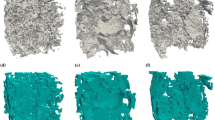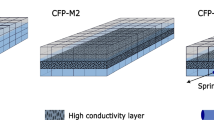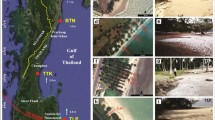Abstract
Wave-induced seepage and its possible contribution to the formation of pockmarks in the Huanghe (Yellow) River delta were investigated experimentally and numerically. Laboratory experiments were carried out to explore the response of a layered silty seabed with various saturation conditions under cyclic wave loads, in which the pore pressure and seepage-related phenomena were particularly monitored. Numerical models to simulate wave-induced seepage in the seabed were presented and evaluated, then applied to the Huanghe River delta. The experimental results show that the excess pore pressure decreases more rapidly at the surface layer, while the seepage-related phenomena are more pronounced when large cyclic loads are applied and the underlying layer is less saturated. The proposed numerical models were verified by comparing with the experiments. The calculated seepage depth agreed well with the depth of the pockmarks in the Huanghe River delta. The experimental and numerical results and the existing insitu investigations indicate that the wave-induced seepage may be a direct cause of the pockmarks in the Huanghe River delta. Extreme storm waves and the dual-layered structure of hard surface layer and weak underlying layer are essential external and internal factors, respectively. Wave- or current-induced scour and transport are possible contributors to the reformation of pockmarks at a later stage.
Similar content being viewed by others
References
Andrews B D, Brothers L L, Barnhardt W A. 2010. Automated feature extraction and spatial organization of seafloor pockmarks, Belfast Bay, Maine, USA. Geomorphology, 124 (1-2): 55–64.
Biot M A. 1941. General theory of three-dimensional consolidation. Journal of Applied Physics, 12 (2): 155–164.
Cathles L M, Su Z, Chen D F. 2010. The physics of gas chimney and pockmark formation, with implications for assessment of seafloor hazards and gas sequestration. Marine and Petroleum Geology, 27 (1): 82–91.
Chan A H C. 1995. User Manual for Diana-Swandyne IIDynamic Interaction and Nonlinear Analysis Swansea Dynamic Program Version II. England: Department of Civil Engineering, University of Glasgow.
Chang R F, Chen Z R, Chen W M et al. 2000. The recent evolution and controlling factors of unstable seabed topography of the old Yellow River subaqueus delta. Journal of Ocean University of Qingdao, 30 (1): 159–164. (in Chinese with English abstract)
Chen Y Y, Liu H J, Jia Y G et al. 2007. Qualitative study on mechanism of liquefaction and seepage of seabed structure silty soil under cyclic loads. Rock and Soil Mechanics, 28 (8): 1 631–1 635. (in Chinese with English abstract)
Chowdhury B, Dasari G R, Nogami T. 2006. Laboratory study of liquefaction due to wave-seabed interaction. Journal of Geotechnical and Geoenvironmental Engineering, 132 (7): 842–851.
Clukey E C, Kulhawy F H, Liu P L F. 1985. Response of soils to wave loads: experimental study. In: Chaney R C, Demars K R eds. Strength Testing of Marine Sediments: Laboratory and In-Situ Measurements, ASTM STP 883. American Society for Testing and Materials, Philadelphia. p.381–396.
Dandapath S, Chakraborty B, Karisiddaiah S M et al. 2010. Morphology of pockmarks along the western continental margin of India: employing multibeam bathymetry and backscatter data. Marine and Petroleum Geology, 27 (10): 2 107–2 117.
Dandapath S, Chakraborty B, Maslov N et al. 2012. Characterization of seafloor pockmark seepage of hydrocarbons employing fractal: a case study from the western continental margin of India. Marine and Petroleum Geology, 29 (1): 115–128.
De Groot M B, Bolton M D, Foray P et al. 2006. Physics of liquefaction phenomena around marine structures. Journal of Waterway, Port, Coastal, and Ocean Engineering, 132 (4): 227–243.
Ding D, Ren Y C, Li S Q et al. 1995. Study on storm deposits in the Yellow River delta and adjacent area. Marine Geology and Quaternary Geology, 15 (3): 25–34. (in Chinese with English abstract)
Dondurur D, Çifçi G, Drahor M G et al. 2011. Acoustic evidence of shallow gas accumulations and active pockmarks in the İzmir Gulf, Aegean sea. Marine and Petroleum Geology, 28 (8): 1 505–1 516.
Dunn S L, Vun P L, Chan A H C et al. 2006. Numerical modeling of wave-induced liquefaction around pipelines. Journal of Waterway, Port, Coastal, and Ocean Engineering, 132 (4): 276–288.
Feng X L, Lin L, Zhuang Z Y et al. 1999. The relationship between geotechnical parameters and sedimentary environment of soil layers since holocene in modern Huanghe subaqueous delta. Coastal Engineering, 18 (4): 1–7. (in Chinese with English abstract)
Hammer Ø, Webb K E, Depreiter D. 2009. Numerical simulation of upwelling currents in pockmarks, and data from the Inner Oslofjord, Norway. Geo -Marine Letters, 29 (4): 269–275.
Harrington P K. 1985. Formation of pockmarks by pore-water escape. Geo -Marine Letters, 5 (3): 193–197.
Hovland M, Judd A G. 1988. Seabed Pockmarks and Seepages. Graham and Trotman, London. 293p.
Jeng D S. 2003. Wave-induced sea floor dynamics. Applied Mechanics Reviews, 56 (4): 407–429.
Jia Y G, Dong H G, Shan H X et al. 2007. Study of characters and formation mechanism of hard crust on tidal flat of Yellow River estuary. Rock and Soil Mechanics, 28 (10): 2 029–2 035. (in Chinese with English abstract)
Judd A G, Hovland M. 2007. Seabed Fluid Flow: the Impact on Geology, Biology, and the Marine Environment. Cambridge University Press, UK. 475p.
Kilhams B, McArthur A, Huuse M et al. 2011. Enigmatic large-scale furrows of Miocene to Pliocene age from the central North Sea: current-scoured pockmarks? Geo -Marine Letters, 31 (5-6): 437–449.
King L H, MacLean B. 1970. Pockmarks on the Scotian shelf. Geological Society of America Bulletin, 81 (10): 3 141–3 148.
Li H D, Yang Z S, Wang H J et al. 2006. Factors of geohazards in the modern Yellow River delta. Marine Geology and Quaternary Geology, 26 (4): 37–43. (in Chinese with English abstract)
Liu H J, Fang Z M, Zhang M S. 2012. Analysis of seepage of unsaturated silty seabed under cycle loads. Periodical of Ocean University of China, 42 (12): 115–119. (in Chinese with English abstract)
Liu H J, Wang H, Zhang M S et al. 2013a. Analysis of waveinduced dynamic response of silty seabed in Yellow River delta. Rock and Soil Mechanics, 34 (7): 2 065–2 071. (in Chinese with English abstract)
Liu H J, Zhang M S, Jia Y G et al. 2006. Analysis of seabed stability under wave loading. Rock and Soil Mechanics, 27 (6): 986–990. (in Chinese with English abstract)
Liu X L, Jia Y G, Zheng J W et al. 2013b. Experimental evidence of wave-induced inhomogeneity in the strength of silty seabed sediments: Yellow River Delta, China. Ocean Engineering, 59: 120–128.
Mory M, Michallet H, Bonjean D et al. 2007. A field study of momentary liquefaction caused by waves around a coastal structure. Journal of Waterway, Port, Coastal, and Ocean Engineering, 133 (1): 28–38.
Moss J L, Cartwright J, Cartwright A et al. 2012. The spatial pattern and drainage cell characteristics of a pockmark field, Nile Deep Sea Fan. Marine and Petroleum Geology, 35 (1): 321–336.
Pau M, Gisler G, Hammer Ø. 2014. Experimental investigation of the hydrodynamics in pockmarks using particle tracking velocimetry. Geo -Marine Letters, 34 (1): 11–19.
Prior D B, Yang Z S, Bornhold B D et al. 1986. Active slope failure, sediment collapse, and silt flows on the modern subaqueous Huanghe (Yellow River) delta. Geo -Marine Letters, 6 (2): 85–95.
Sakai T, Hatanaka K, Mase H. 1992. Wave-induced effective stress in seabed and its momentary liquefaction. Journal of Waterway, Port, Coastal, and Ocean Engineering, 118 (2): 202–206.
Salmi M S, Johnson H P, Leifer I et al. 2011. Behavior of methane seep bubbles over a pockmark on the Cascadia continental margin. Geosphere, 7 (6): 1 273–1 283.
Santos I R, Eyre B D, Huettel M. 2012. The driving forces of porewater and groundwater flow in permeable coastal sediments: a review. Estuarine, Coastal and Shelf Science, 98: 1–15.
Sassa S, Sekiguchi H. 1999. Wave-induced liquefaction of beds of sand in a centrifuge. G é otechnique, 49 (5): 621–638.
Sultan N, Marsset B, Ker S et al. 2010. Hydrate dissolution as a potential mechanism for pockmark formation in the Niger delta. Journal of Geophysical Research: Solid Earth, 115 (B8): 1–33.
Sumer B M, Fredsøe J. 2002. The Mechanics of Scour in the Marine Environment. World Scientific, Singapore.
Tzang S Y, Ou S H. 2006. Laboratory flume studies on monochromatic wave-fine sandy bed interactions: part 1. Soil fluidization. Coastal Engineering, 53 (11): 965–982.
Xu D S, Wang R, Meng Q S et al. 2010. Experimental research on in-situ mechianical properties of silt in Yellow River delta. Chinese Journal of Rock Mechanics and Engineering, 29 (2): 409–416. (in Chinese with English abstract)
Xu G H, Sun Y F, Wang X et al. 2009. Wave-induced shallow slides and their features on the subaqueous Yellow River delta. Canadian Geotechnical Journal, 46 (12): 1 406–1 417.
Yamamoto T, Koning H L, Sellmeijer H et al. 1978. On the response of a poro-elastic bed to water waves. Journal of Fluid Mechanics, 87 (1): 193–206.
Yang S L, Shen W Q, Yang Z S. 1995. The mechanism analysis of seafloor silt liquefaction under wave loads. Chinese Journal of Geotechnical Engineering, 17 (4): 28–37. (in Chinese with English abstract)
Zen K, Yamazaki H. 1990. Mechanism of wave-induced liquefaction and densification in seabed. Soils and Foundation s, 30 (4): 90–104.
Author information
Authors and Affiliations
Corresponding author
Additional information
Supported by the National Natural Science Foundation of China (No. 41072216) and the Science and Technology Development Program of Shandong Province (No. 2014GGX104007)
Rights and permissions
About this article
Cite this article
Wang, H., Liu, H., Zhang, M. et al. Wave-induced seepage and its possible contribution to the formation of pockmarks in the Huanghe (Yellow) River delta. Chin. J. Ocean. Limnol. 34, 200–211 (2016). https://doi.org/10.1007/s00343-015-4245-0
Received:
Accepted:
Published:
Issue Date:
DOI: https://doi.org/10.1007/s00343-015-4245-0




